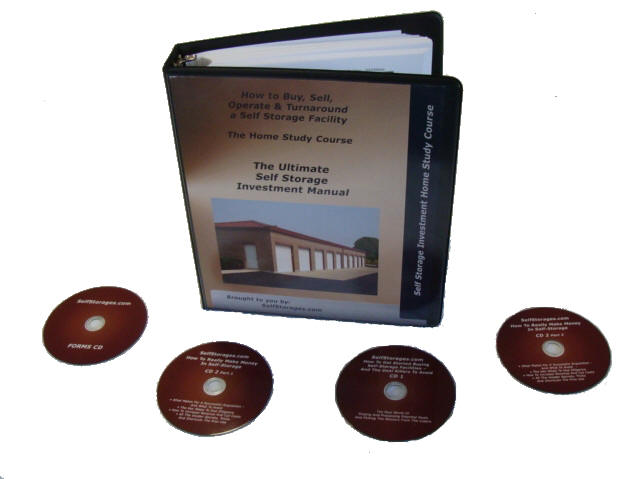If you thought you’d heard it all, check out the article below on the most expensive self-storage space in the world. Thank heavens for the materialism of the American consumer, as there would be no self-storage industry without it. But when people start spending as much on self-storage units as the median home price in the U.S., it makes you really take notice as to the fervor of the American desire to accumulate material possessions. Is there anything wrong with that? Not really. Most of the complaints against such activity comes from other nations who, to be blunt, may be just jealous of our financial strength. That’s why there is more self-storage space in the U.S. than all the rest of the world combined.
Memo From Frank & Dave
How To Buy A Property At Auction
There are great self-storage deals to be found at auction. We’ve bought properties for 50% less than true value. However, there are also great dangers. So if you want to take advantage of buying properties at auction, you need to know the risks and how to mitigate them.
The basic format
Buying at auction typically follows a certain format which, while it may vary based upon the auctioneer and what the seller selects, is basically always the same methodology. First, the seller places the property with the auctioneer to be auctioned at a certain sale date. The auctioneer then advertises it, and prepares the marketing materials, which typically include the known financial statements and other pertinent information (including third party reports in some cases, on such issues as environmental contamination). The buyer does their due diligence before the date of the sale. On the date of the sale, the buyers make bids – either “open” (for everyone to see) or “closed” (in which nobody knows what anyone else bid). The winning bidder, after confirmation from the auctioneer, then puts up a deposit (typically 10%) and has a certain length of time (normally 30 days) to come up with the rest of the money. If they fail, the seller keeps the deposit and puts it on the market again.
How it works in real life
In real life, however, things never work exactly as the theory would suggest. Most buyers don’t have an interest in doing due diligence on a property that they may fail to win, so many good buyers will simply refuse to participate (that’s why there are so many good deals to be had). And the information provided by the seller is often sketchy, as many times these properties are foreclosures and there are no records to look at. Then there’s always the problem of the seller refusing to ratify the winning bid because they hoped for more money. The bottom line is that it’s far from a perfect business model, for either the buyer or seller.
Things to watch out for
Never bid at an auction unless you have done decent due diligence on the property. History is full of examples of buyers who thought that the price seemed cheap and made a bid without any research at all, and only then found that they’d made a huge mistake. I know of a property that only appraised for half of the winning bid, because the buyer had missed a ton of expense items and deferred maintenance. So you have to know what you are really buying. Another prime mistake is to be unable to get the financing needed in the 30 days, and then lose your deposit. It is really, really hard to get a bank loan in 30 days, so be prepared to pay all cash if necessary.
Benefits of buying at auction
The big benefit of buying at auction is that the whole process scares off a ton of buyers. In fact, if you look at it factually, selling at auction is about the dumbest thing a seller can do. Typically, the bank knows this is the case, but they are too lazy to want to find a broker, and work with a bunch of buyers over a period of time. They just want to get the property out of their hair immediately and will take a huge hit on the price just to accomplish this. This flaw is what creates all the opportunity. Other than a low price, there’s really no good reason that you’d ever want to buy in an auction format, as it can often waste your time and put a huge amount of pressure on you if you are the successful bidder.
Conclusion
We love buying properties at auction. And we hate buying properties at auction. Most self-storage owners share this bipolar disorder. You can get some unbelievable deals at auction. But you can also get destroyed if you do not mitigate your risks.
Now Here’s Something You Don’t See Stored Every Day

The Dallas Railroad Museum lost its home at Fair Park in Dallas, and while part of the collection was moved to Frisco, Texas, a huge amount of the train collection can now be found in a fenced-in yard of a railroad spur. These are some amazing railroad cars from the 1920s to 1960s, from engines to Pullmans, which now just sit in an abandoned area near Fair Park. Who knows what all can be found in storage across America.
New Facilities for Sale on SelfStorages.com
Here’s An Interesting Statistic
There is enough self-storage in the U.S. that every man, woman and child could stand inside of one –at the same time! When you talk about Americans needing a roof over their heads, we’ve already got every single person covered with the roughly 50,000 self-storage facilities in the U.S.
Self Storage Home Study Course
Our Home Study Course is not like anything you have ever listened to or read before. We do not fill it with a bunch of fluff on how your are going to make a million bucks with no money down. We tell you the whole story... the good, the bad, and the sometimes ugly.
Click Here for more information.
How To Buy A Self-Storage Facility Using A Master Lease With Option
What do you do when a seller wants a certain price but the numbers simply don’t support that amount. You can’t get a bank loan when there’s not enough cash flow to cover the mortgage. So how do you bridge the gap between the seller’s fantasy and the current reality? You can either walk the deal or, if you think it has the potential to be worth more than the asking price in end, you can pitch a different path: the Master Lease with Option.
The basic deal points
So how does a Master Lease with Option work? Essentially, you agree to a sales price with the seller, but one that you have the option to exercise of a period of time (typically 3 to 5 years). In the interim, you take full control of the mobile home park under a master lease, and go about improving its financial performance to warrant that price.
How to make an average deal into a great deal
The Master Lease with Option structure has some huge benefits. It allows you to test out your theories without risking your hard-earned dollars. And it also allows you to get the property running on all 8 cylinders before you close on it, elevating an average deal into a great deal in the process.
What to watch out for
There is one big danger in doing a Master Lease with Option deal. And that’s getting the seller to sign the paperwork to close after you’ve turned their self-storage facility around. Under a traditional purchase, the seller is out of the picture when you make things better. But in a Master Lease with Option, they watch you improve the revenue and cut the costs, and they get mad when they have to sell a fixed property for a broken property price. Make sure that everything you do is in writing and that the seller has no “escape” clauses. We have had to threaten to sue many sellers to get these deals closed.
Understand what can – and cannot – be fixed about that self-storage facility
You can’t fix a bad location. You can’t fix poor visibility. You can’t fix market-wide vacancy issues. But you can fix marketing, management, cost-cutting and those type of items. The best opportunities we have seen are in the marketing arena. Many older moms & pops are unsuitable for internet marketing, which has become the #1 way to reach customers. If you could tie up a 50% occupied self-storage facility that has no internet marketing and then push it to 100% by hitting the net, then that would be a dream Master Lease with Option candidate.
Conclusion
When you are looking at deals to buy, one more weapon in your arsenal is the Master Lease with Option. In certain cases, it can be the best way to get a great deal.
The Most Expensive Self-Storages In The World
The condominiums at 93 Worth St. in Manhattan's Tribeca neighborhood are the home to what could be some of the most expensive self-storage space in the world. If you thought that New York City already boasts insanely high apartment rents and home prices, then you may still be shocked at what people will pay for storage space.
You won’t believe these prices
In a building that has a $10 million penthouse, you would expect things to be a bit pricey. But check this out. A 4’ x 8’ steel storage cage – a fraction of a standard 10’ x 10’ storage unit at a Public Storage lot – recently sold for $65,000. That works out to around $2,000 per square foot, which is more than the priciest home in Tokyo. Said the building’s developer “I mean, the rationale behind it, it’s hard to justify. We all still live in a space which is smaller than we want to. That extra space is always the most valuable.” That’s an understatement. The following are reported to be some of the priciest rates per square foot in New York City:
- 56 Leonard St.: $300,000, or $1,500 per square foot
- 157 W. 57th St.: $216,000, or $4,000 per square foot
- 432 Park Ave.: $190,000, or $2,500 per square foot
- 252 E. 57th St.: $155,000, or $1,220 per square foot
- 520 Park Ave.: $95,000, or $2,065 per square foot
- 93 Worth St.: $65,000, or $2,031 per square foot
Those prices would make Donald Trump cringe.
How do you even rationalize those prices?
Wealthy buyers from around the world have been buying over-the-top apartments in Manhattan for a decade. And these same buyers have items that won’t fit in their units, and things that they refuse to part with. So the new boom in New York City self-storage units is really the result of two factors: 1) self-storage occupancy (which stands at over 90% in New York City) and 2) unbridled spending that makes no sense in a rational world. When you have customers who spend millions to own private jets and race horses, these numbers pale in comparison. But to the average American they seem completely insane.
Conclusion
Got s few hundred thousand dollars burning a hole in our pocket. Then head to Manhattan and get a storage locker!
Brought To You By SelfStoragesUniversity.com
If you need more information please call us (855) 879-2738 or Email [email protected]
